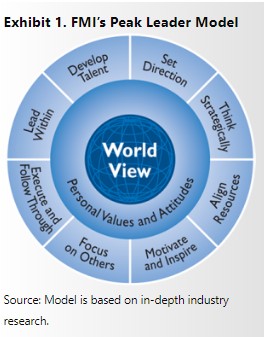How Exceptional Leaders Drive High-Performing Building Products Manufacturing Teams

How building product manufacturers can successfully connect the dots between exceptional leaders and high-performing teams.
In today’s building product manufacturing environment, developing extraordinary leaders—those who clearly articulate direction, leverage and align resources to maximize opportunity, and inspire and motivate greatness in others—has become an absolute imperative.
The problem is that most building product manufacturing (BPM) organizations aren’t putting enough time and effort into developing their teams. This is an especially critical oversight in the current labor market, where skilled workers and experienced leaders are getting harder and harder to find. And when BPMs do find employees who fit their criteria, the manufacturers aren’t always thinking about the team as a whole. They don’t see their organizations as a series of individual teams that are completing projects.
For example, not everyone can be a coach and not everyone can be an offensive player. Teams also need good defensive players and strategists who can help organizations look at the big picture and get to the next level. In breaking down a 12-month period, for example, a BPM may be focused on three different product launches. Each of those launches requires a team that’s set up, in place and ready to make sure the proposed plan is operating efficiently and effectively.
Multifaceted, Complex Systems
Looking across the BPM industry, there is a multifaceted and integrated system of people and behaviors—as well as technology and processes—aimed at addressing large, complex problems. The rise of megaprojects (i.e., projects of $500 million or larger) is one example of the increased complexity leaders face in today’s business environment. Mega or not, today’s projects demand more information, more coordination and more integration than ever before.
This new paradigm creates an environment where larger, more diverse teams must operate more efficiently across departments, organizations and geographies—a trend that’s being driven by owner expectations for faster, better and cheaper project outcomes. In the simplest of environments, the most efficient team is a team of one that requires only self-leadership and minimal coordination to complete a task.
But look at your daily schedule and you’ll see that the time dedicated to individual contribution is very limited. Once teams expand beyond one person, the required amount of coordination and integration grows exponentially. According to a recent study, the average person receives 304 weekly business emails and checks his or her email 36 times per hour. The average team member attends 62 meetings monthly, and half of the time, these meetings are considered wasted time.
Let’s face it—companies waste a lot of time.
Addressing these and other challenges begins with taking a step back and fundamentally recognizing that engineering and construction is a team sport where synergy, alignment and commitment to one common purpose make or break success. This should be followed by a renewed focus on how to effectively lead teams that operate at peak performance despite generational differences and rising complexity. Exceptional team leaders maximize available talent while creating a magnetic pull for the types of people today’s organizations increasingly need.
Breaking It All Down
By breaking the organization (or the strategy) down into specific goals and then establishing teams that have a clear sense of purpose around those goals, exceptional leaders can effectively drive high-performing BPM teams. The problem is that many companies don’t take the time to do this, and then they end up with misaligned people, leaders and strategies.
When you consider the drivers of high-performing teams, whether examining dynasty-like sports franchises or reflecting on those construction project teams that consistently exceed delivery expectations, these foundational principles always seem to be in place:
- A clear sense of common team purpose.
- A deep synergy and an abiding trust among team members.
- A clear alignment of roles and team behaviors.
- Well-established and clearly communicated processes and systems that enable timely decisions, create stretch goals, elevate accountability and deliver results as a unit of one.
Think about the last time you were on a team that delivered consistently high-quality outcomes and results. That team probably operated with a sense of having one, unified goal versus acting as a group of individuals pursuing separate targets. Team trust and open lines of candid, effective communication are more likely prevalent, bringing speed and effectiveness to addressing obstacles and overcoming schedule challenges.
It is also likely that a set of clear team rules and roles were in place, thus eliminating ambiguity related to performance expectations and personal accountabilities, and creating little wasted motion or lost production time.
Before game day or the start of a new project, these behavioral norms, processes and expectations have already been put in place, reinforced and practiced. This is all done with the understanding that when the game begins and challenges of unforeseen obstacles arise or changes in owner expectations occur, these behaviors and processes allow teammates to lean on one another. This kind of framework can help leverage the team’s collective wisdom and skills and ultimately lead to better results.
Here are some examples of peak teams in action:
Architects, designers and contractors
The fastest-growing and most popular method used to deliver construction projects in the U.S., design-build provides a great example of how companies leverage peak teams. In this arrangement, the owner manages just one contract with a single point of responsibility. The designer and contractor join forces at the project outset, providing unified project recommendations to fit the owner’s schedule and budget. Any project changes are addressed by the entire team—an arrangement that invites collaborative problem-solving and innovation (versus excuses and blame-shifting). While single-source contracting is the fundamental difference between design-build and more traditional construction approaches, the culture of collaboration that’s inherent in design-build is equally as important.
Marketing departments, product development and sales teams
These three entities come together to listen to the customer and to make sure the product is relevant to the market. Peak teams ensure that end users’ (i.e., the buildings occupants) feedback is taken into consideration to drive product development and innovation. Marketing effectively draws out ideas and feedback from customer communities through research, surveys, interviews and focus groups, while product development translates that information into product innovation.
Inside sales, field sales and customer service teams
High-performing sales teams capture input from all the organization’s customer-facing sales and sales support teams. They then convert that intelligence into insights that help companies stay focused on the right customers, the right products and the right applications that, in turn, help building product manufacturers deliver growth and margins.
Setting Direction and Following Through
Leadership’s role in today’s increasingly complex construction environment can be dramatic. In fact, leadership development can be an organization’s competitive advantage, or it can be its Achilles’ heel.
 So how can an organization know if the leaders are achieving success? FMI’s experience in the industry has led to the development of the Peak Leader model, which helps evaluate leadership performance and plan for individual leader development based on these essential leadership behaviors: set direction, think strategically, align resources, motivate and inspire, focus on others, execute and follow through, lead within and develop talent.
So how can an organization know if the leaders are achieving success? FMI’s experience in the industry has led to the development of the Peak Leader model, which helps evaluate leadership performance and plan for individual leader development based on these essential leadership behaviors: set direction, think strategically, align resources, motivate and inspire, focus on others, execute and follow through, lead within and develop talent.
Let’s look at two of the most important leadership behaviors that serve as strong predictors of overall success and which are amplified when used with teams:
Set direction: Establish the why, how and where. One of leadership’s primary responsibilities is charting the team’s course. Defining objectives, connecting those objectives with the larger organizational objectives, and then showing how each team member contributes to success can be liberating for high performers on any team. With a clear direction, team members are empowered to fully engage, solve problems and act intentionally to achieve the overall organizational objectives. When the direction is unclear, team members must constantly check in for additional guidance, get permission for any change in action, and continually seek reassurance that what they are doing is right. Remember those 304 emails a week? This is a symptom of leaders who are not effectively setting direction. If your team members constantly check in on small details, ask for your permission or “run stuff by you,” it may be an indication that you can increase your leadership effectiveness by clearly setting direction and engaging your team to pursue results on their own.
Execute and follow through. Many leaders in the BPM industry worry that an increased focus on leadership behaviors, such as setting direction and creating a project team purpose, will distract them from getting their work done. To resolve this concern, FMI turns to the Peak Leader model and looks to engage the leadership behaviors around execute and follow through. When leaders are performing at a high level in “execute and follow through,” there is clarity around how they will communicate as leaders and how the systems and processes will ensure individual accountability. Far too often in BPM, leaders overlook their communication systems, relying too heavily on email and phone calls to address immediate issues and underestimating the power of highly effective meetings and team integration in communication. For example, do your team members know the most important communication points and the required timing and extent of such information across the team?
Connecting the Dots
Winning the team game in the building product manufacturing industry today, and in the future, will require highly synergized, aligned and progress-oriented teams that are led by exceptional leaders. Building and reinforcing these kinds of teams—whether in the boardroom, at weekly operations meetings or on the job site—remain the signature of exceptional leaders and sustainable organizations.
In sports, for example, a team’s purpose is to win a championship (be it a local, state or national award). When BPMs assemble high-performing teams, they often forget to develop a clarity of purpose for those teams. But if you’re not clear on your purpose, then how do you know whether you have a peak-performing team (or not)?
Finally, you’ll want to create a series of filters for everything that your teams do. For example, if the goal is to get new customers, then everything that the team does needs to be in front of people who have never bought from your company before. Create attainable goals around this larger mission, and then measure your team’s and leader’s success at reaching these goals. This will help your organization stay focused on its core mission while also helping it successfully connect the dots between exceptional leaders and high-performing teams.
Connect with our Building Product Manufacturing Team



